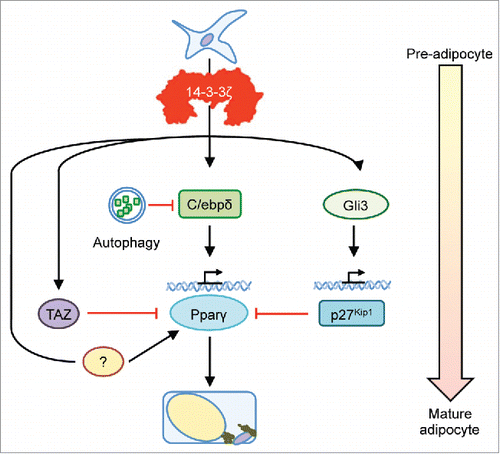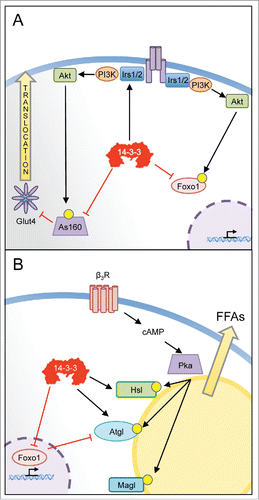Figures & data
Figure 1. Potential involvement of 14-3-3ζ in alternative pathways controlling adipogenesis. Although we reported the upstream actions of 14-3-3ζ on C/ebpδ stability and Gli3-regulated p27Kip1 activity during adipogenesis, the ability of 14-3-3ζ to primarily bind to phosphorylated proteins harboring its canonical motifs, and to a lesser extent non-phoshorylated proteins, suggest that it may regulate the activity of known and unknown adipogenic factors. For example, TAZ, which competes with Pparγ occupancy during adipocyte differentiation, is one such 14-3-3 protein binding partner. Discovery of the 14-3-3ζ interactome during adipogenesis may aid in the discovery of novel effects of adipocyte differentiation.

Figure 2. Potential actions of 14-3-3ζ in the mature adipocyte. (A) 14-3-3ζ is known to interact with various insulin signaling effectors that facilitate glucose uptake. Biochemical studies have shown that 14-3-3ζ and other isoforms can regulate the stability of insulin receptor substrate molecules (IRS)-1 or -2, which are key proximal effectors. Following their phosphorylation by Akt, 14-3-3 proteins have been shown to control the transcriptional activities of Foxo1, by promoting its retention in the cytosol. 14-3-3 proteins have also been shown to control the inhibitory actions of the Rab-GAP As160/TBD1C4, which regulates the translocation of Glut4-containing vesicles to the plasma membrane for glucose uptake. (B) By recognizing phosphorylated forms hormone sensitive lipase (Hsl) or adipose triglyceride lipase (Atgl), 14-3-3ζ may directly regulate lipolysis of stored triglycerides. The expression of Atgl is regulated in part by Foxo1, whose transcriptional activity is controlled by 14-3-3ζ. Thus, 14-3-3ζ may regulate lipolysis through direct actions on key lipolytic enzymes and by influencing their protein abundance. Further studies are required to directly assess whether 14-3-3ζ has such roles in a mature adipocyte.

